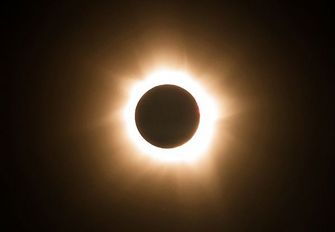« Prev Next »

If you were following the news last October, you probably heard or read about the Nobel Committee’s choices for the 2013 series of Nobel Prizes. From Chemistry to Literature, the public was awestruck at the amazing accomplishments of last year’s recipients. Yet, no single award stood in more distinction – or was more easily predicted – as this year’s Nobel Prize in Physics, which was awarded to the prominent physicists Peter Higgs and Francois Englert.
Like many winners of the Prize, Higgs and Englert were rewarded for theories they had formulated years ago – in this case, about fifty years ago, in 1964. So, what did these scientists do to overwhelmingly sweep consideration for the Prize?
Well, they were the first scientists
to theorize the God Particle. As
daunting as that sounds, the God Particle, also known as the Higgs Boson, is
actually smaller than you’d expect. In
fact, it’s smaller than any subatomic particle currently known to man. But the reason that it derives so much
importance – more importance than any of the other hundreds of particles that
were discovered during the twentieth century – is its ability to explain the
origins of mass.1
In 1964, Higgs and Englert (along
with several other scientists only a few weeks later) described a new type of
quantum field, one which pervaded all of space.
This field was essentially a basic form of energy; when particles passed
through the field, they gained energy in small quantities until they
accumulated that energy as mass (remember, by Einstein’s famous E=mc^2, we know
that there is a relationship between energy and mass). This field, appropriately, is known as the
Higgs field, and the “quanta” (plural of “quantum”) of energy with which the
field interacts with other particles are known as Higgs Bosons.2
Mass seems to be an important
concept in physics in and of itself, but this idea does not explain fully the
significance of the Higgs Boson. Rather,
to explore this issue further, we need to analyze the importance of the
Standard Model of particle physics.
The Standard Model is an attempt to
understand and unify how particles interact with each other through a series of
forces. It is considered the most
successful of the several theories proposed to encompass all of the many
discoveries that have been made over the past two centuries. Yet, the Standard Model relies on one
fundamental principle: accumulation of mass through the Higgs field. Since the creation of the theory, scientists
have merely assumed the existence of the Higgs Boson and used it to justify the
Standard Model; well, now there’s proof.3

So, readers, raise a hearty “congratulations” to Peter Higgs and Francois Englert, the winners of the 2013 Nobel Prize in Physics "for the theoretical discovery of a mechanism that contributes to our understanding of the origin of mass of subatomic particles, and which recently was confirmed through the discovery of the predicted fundamental particle, by the ATLAS and CMS experiments at CERN's Large Hadron Collider.”5 For such a small particle, it truly is a remarkable phenomenon and an equally remarkable discovery. The world of particle physics will never be the same.
References:
1. Overbye, Dennis. "For Nobel, They Can Thank the ‘God Particle’." The New York Times. N.p., 08 Oct. 2013. Web.
2. Thompson, Nick. "What Is the Higgs Boson and Why Is It Important?" CNN. Cable News Network, 08 Oct. 2013. Web.
3. Brumfield, Ben. "'God Particle' Theorists Receive Nobel Prize in Physics." CNN. Cable News Network, 08 Oct. 2013. Web.
4. "CERN Accelerating Science." The Search for the Higgs Boson. N.p., n.d. Web.
5. "All Nobel Prizes in Physics." NobelPrize.org. The Nobel Foundation, n.d. Web.
Image Source (Higgs and Englert): Daily Mail
Image Source (Proton-Proton Collision): CNN

Watch Star Trek or Star Wars, read Hitchhiker’s Guide to the Galaxy, or flip through Dune and take note of the most effective means of travel. Yes, via spacecraft; however, captains of the Millennium Falcon and the Starship Enterprise know too well that the fastest way to any destination is via light speed. They make the jump to hyperspace. Most avid watchers simply accept this remarkable concept, given that it exists “so far” into the future. To my surprise, though, the thought of sending an object at speeds faster than light is a concentrated and developed field of scientific study. So, let’s make the jump and explore.
Now, the concepts of hyperspace and light speed extend far beyond the realm of sci-fi. In fact, a group of Physics students at the University of Leicester have actually calculated what a realistic hyperspace would look like. Despite what popular film and television might convey – a blur of blue colors and an object stretching faster than the eye can believe – a journey into hyperspace would be quite simply defined. The students Riley Connors, Katie Dexter, Joshua Argyle, and Cameron Scoular say, “the crew wouldn’t see star lines stretching out past the ship during the jump to hyperspace, but would actually see a central disc of bright light. This is due to the Doppler effect, specifically the Doppler blue shift.”

Simple enough, but let’s introduce the Doppler blue shift, which links a concept inherent to sound waves to the electromagnetic, and consequently visible light, spectrums. The “blue shift” and its counterpart the “red shift” are commonly coined astronomy terms regarding the perceptible effects of planetary movement. Yet the fourth-year theoretical physicists provide a different application: “[the jump] results in the wavelength of electromagnetic radiation, including visible light, shortening as the source of the light moves towards the observer.” However, the sudden shift to light speed would cause the rays of light to actually switch from the visible spectrum to the x-ray spectrum (that’s blue shift).
What is truly amazing is that these avid physicists took a step further in their light-speed research. They calculated that the pressure an object, even the Millennium Falcon, would feel if it had the capacity and energy to enter light speed would be comparable to the pressure at the bottom of the Pacific Ocean! So, unless science takes lessons from Lucasfilm (the creators of the Star Wars franchise), it doesn’t seem that the concept of traveling through Hyperspace will hold much water. While it would be extremely efficient, the jump consumes too much energy, exerts too much pressure on the object, and most of all… would be blinding to the eyes! Like student Riley Connors said, “Sunglasses would be certainly advisable.”
Sources:
1. Students Paper: https://physics.le.ac.uk/journals/index.php/pst/article/view/549/360
2. Doppler Effect: http://scienceworld.wolfram.com/physics/DopplerEffect.html

Solar eclipses! The moon moves into a specific location that blocks the sun's light from reaching earth. But how often do eclipses occur and what are their conditions? What kinds of eclipses exist?
Now, Solar Eclipses don't happen once in a blue moon... actually, more like once in a new moon, when the Sun and the Moon are in "conjunction" with each other. If you're not an astronomy buff, conjunction most simply means that the celestial bodies have the exact same ecliptic longitude (they are in a line with each other). Now, if you think about it, by that definition, a solar eclipse would happen every month! Unfortunately, though, the moon's orbit is elliptical, rather than circular. This makes the overlap much more rare, so of the two to five eclipses that occur every year, only two are total eclipses.
Wait. What's a total eclipse? Well, a total eclipse is just one of the four different types of solar eclipses that can happen throughout an eighteen-month cycle. The total eclipse is very simple, just what it sounds like -- the moon completely blocks out the sun. Similarly, an annular eclipse is when the moon and the sun are completely aligned, but the "size" of the moon is just a tad bit smaller than that of the sun. This causes an annulus, or a bright solar ring, to form around the moon. When both a total and annular eclipse seem to coexist, the phenomenon is called a hybrid of the two... the hybrid eclipse (how original). Although the hybrid is one of the most fascinating eclipses that exist, it is potentially the rarest -- very few have occurred in the past few decades, given that they are also extremely difficult to predict. The last, and most common, type of eclipse is the partial eclipse, where the Sun and the Moon aren't completely in line and, as a result, the sun is only partially covered.
Ok, so you've gotten your fill of background information on eclipses, but where's the cool stuff? To me, what's cool is the facts and fiction behind eclipses. For example, is it really necessary to wear eye protection during an eclipse? I mean, the sun is being covered by the moon, and the last time I checked the moon didn't scorch my eyelids. Well, I hate to be the bearer of bad news but, during annular, partial, or even hybrid eclipses, the small amount of sunlight which the moon doesn't block has the same destructive effects as the regular sun. To guarantee your safety, it is highly recommended that you follow either of these two precautionary measures:
1) Wear eclipse glasses, which use specialized solar filters to block out the solar rays.
or
2) Use indirect projection. Potentially the safest method, this is done by projecting an image onto a white piece of paper using a device called a pinhole camera (see image to the right). Remember to take precautionary measures even during a total eclipse; they only last around seven and a half minutes and the sun could peek out at any time and fry your eyeballs!

Additionally, over the years, some people have reported other anomalies that happen during solar eclipses. In 1954, Maurice Allais reported strange movement, later attributed to shifts in gravity, during the eclipses. In 1970, Erwin Saxi noted changes in pendulum motion during eclipses; a phenomenon known now as the Saxi effect.
Probably the coolest phenomenon, though, is the transit of another planet during a solar eclipse. A transit is another technical term that means that the planet "transiting" moves in front of the field of vision of another celestial being. In this case, the transit of planets like Mercury or Venus during a solar eclipse would cause them to come into perfect view without any magnification! However, this is EXTREMELY rare -- for example, the next transit of Mercury is predicted to be on July 5th! of 6757...
It's really easy to find out when the next eclipse is -- check out this awesome link to stay updated: http://www.moongiant.com/Solar_Eclipse_Calendar.php. Better get your eclipse glasses ready!
References:
Espenak, Fred (July 11, 2005). "Eye Safety During Solar Eclipses". NASA Goddard Space Flight Center.
Littmann, Mark; Espenak, Fred; Willcox, Ken (2008). Totality: Eclipses of the Sun. Oxford University Press.
Schaefer, Bradley E. (May 1994). "Solar Eclipses That Changed the World". Sky and Telescope 87 (5): 36-39.
























